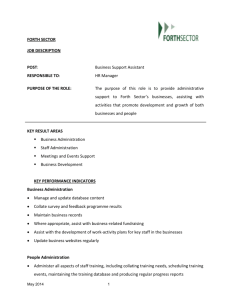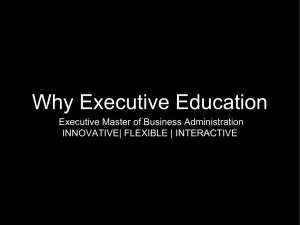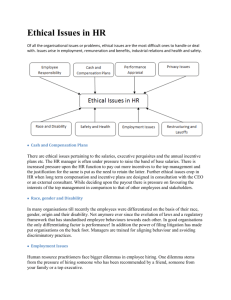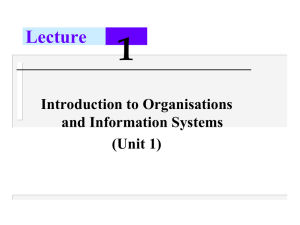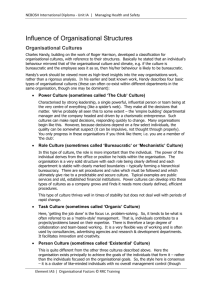3. Risk Management
advertisement
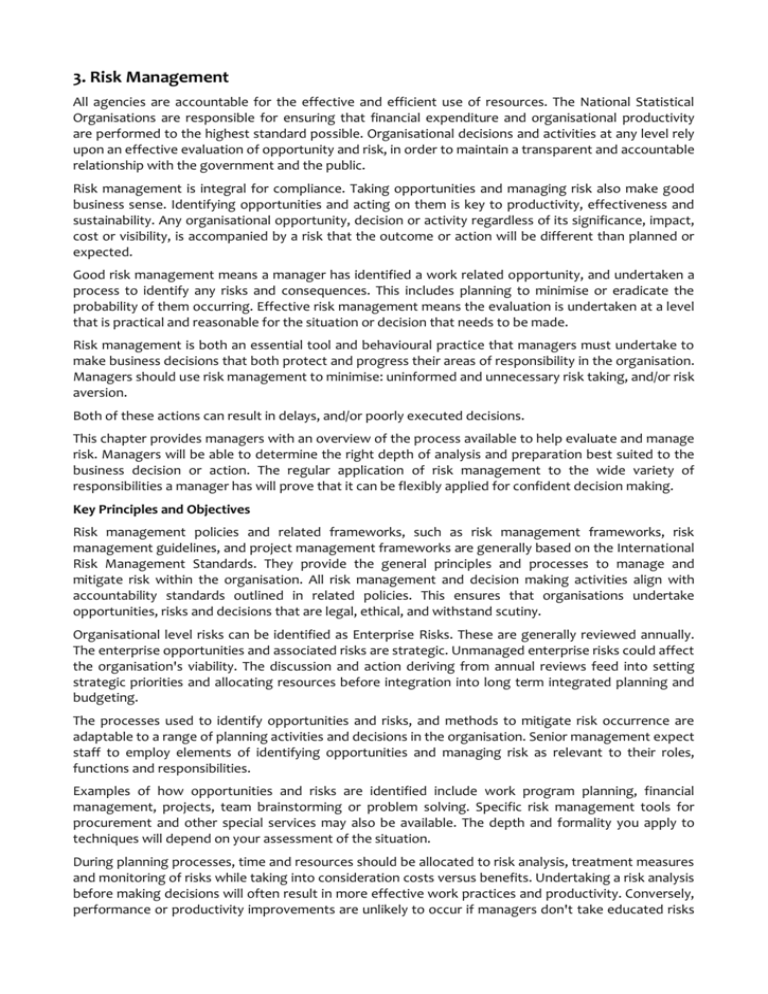
3. Risk Management All agencies are accountable for the effective and efficient use of resources. The National Statistical Organisations are responsible for ensuring that financial expenditure and organisational productivity are performed to the highest standard possible. Organisational decisions and activities at any level rely upon an effective evaluation of opportunity and risk, in order to maintain a transparent and accountable relationship with the government and the public. Risk management is integral for compliance. Taking opportunities and managing risk also make good business sense. Identifying opportunities and acting on them is key to productivity, effectiveness and sustainability. Any organisational opportunity, decision or activity regardless of its significance, impact, cost or visibility, is accompanied by a risk that the outcome or action will be different than planned or expected. Good risk management means a manager has identified a work related opportunity, and undertaken a process to identify any risks and consequences. This includes planning to minimise or eradicate the probability of them occurring. Effective risk management means the evaluation is undertaken at a level that is practical and reasonable for the situation or decision that needs to be made. Risk management is both an essential tool and behavioural practice that managers must undertake to make business decisions that both protect and progress their areas of responsibility in the organisation. Managers should use risk management to minimise: uninformed and unnecessary risk taking, and/or risk aversion. Both of these actions can result in delays, and/or poorly executed decisions. This chapter provides managers with an overview of the process available to help evaluate and manage risk. Managers will be able to determine the right depth of analysis and preparation best suited to the business decision or action. The regular application of risk management to the wide variety of responsibilities a manager has will prove that it can be flexibly applied for confident decision making. Key Principles and Objectives Risk management policies and related frameworks, such as risk management frameworks, risk management guidelines, and project management frameworks are generally based on the International Risk Management Standards. They provide the general principles and processes to manage and mitigate risk within the organisation. All risk management and decision making activities align with accountability standards outlined in related policies. This ensures that organisations undertake opportunities, risks and decisions that are legal, ethical, and withstand scutiny. Organisational level risks can be identified as Enterprise Risks. These are generally reviewed annually. The enterprise opportunities and associated risks are strategic. Unmanaged enterprise risks could affect the organisation's viability. The discussion and action deriving from annual reviews feed into setting strategic priorities and allocating resources before integration into long term integrated planning and budgeting. The processes used to identify opportunities and risks, and methods to mitigate risk occurrence are adaptable to a range of planning activities and decisions in the organisation. Senior management expect staff to employ elements of identifying opportunities and managing risk as relevant to their roles, functions and responsibilities. Examples of how opportunities and risks are identified include work program planning, financial management, projects, team brainstorming or problem solving. Specific risk management tools for procurement and other special services may also be available. The depth and formality you apply to techniques will depend on your assessment of the situation. During planning processes, time and resources should be allocated to risk analysis, treatment measures and monitoring of risks while taking into consideration costs versus benefits. Undertaking a risk analysis before making decisions will often result in more effective work practices and productivity. Conversely, performance or productivity improvements are unlikely to occur if managers don't take educated risks to exploit business opportunities. Risk management enables managers to undertake new business/operational challenges and manage the risks. Using risk management provides a level of assurance and accountability in decision making and an action plan if outcomes differ from those expected. Tips: Use risk management constantly, and adapt the level and formality depending on the issue. Note that not making a decision creates an additional set of risks. Maintain records of decisions and actions - you are accountable. Make sure staff apply these principles to their ongoing activities and responsibilities. Attend training in managing risk where offered. Your Role Managers need to understand their operating environment to align work program priorities and performance expectations with the organisations objectives and performance standards. Furthermore, success and productivity relies upon its staff, especially managers to subscribe to continuous improvement, and scope opportunities to evolve, innovate and enhance current business. Opportunity is usually accompanied by risk, and a manager's role is to decide if opportunity outweighs risk or whether the risk can be reduced through treatment measures. Managers make work related decisions constantly, either formally in line with delegations or informally in relation to daily work functions, projects, and good team management. Organisations rely upon managers to use risk management to strive for high quality business outcomes. Managers must ensure the amount of effort put into these activities is consistent with the context of the situation and expected outcomes. From risk identification to treatment phase, managers make choices on which they take responsibility against their own organization and the resources managed and also are accountable for the goals attained. Key Processes and Issues Good risk management is a business process that improves the standard and value of work output and outcomes in all business areas. Due to the ongoing/cyclical nature of our work, the Project Management Framework and risk management processes are frequently applied to meet timeframes, budget and high quality project outcomes. Risk management is used for statistical quality assurance (such as quality gates), improving the relevance of the statistical work program, ensuring business continuity of systems, and for financial management, such as procurement activities. Risk evaluation is also useful to a manager when preparing for performance related conversations with staff. Preparation increases optimal outcomes. Identifying Opportunities Organisations and senior executive rely on managers to use their experience and knowledge to contribute to a focus on productivity and innovation. A manager must focus on identifying opportunities, and enable them to be practically implemented. Managers are encouraged to continuously assess the external environment in line with client service standards and national statistical service objectives, and look to identify improvements in flexibility and productivity. Organisational opportunities can make a difference at any level, and managers are expected to encourage staff, through their example, to be proactive in assessing opportunities for performance and productivity improvement. New opportunities also come with elements of risk that may impede positive outcomes if not managed effectively. Assessing Risk Risk not identified, or left unmanaged may lead to the following organisational outcomes: enterprise (strategic and may significantly impact on the organisation) operational (may impact on a program's objectives and/or outcomes) project (may impact on the project objectives and outcomes). Generally, risk assessment activities are located in an organisation’s Risk Management Framework. While all steps are important, it is vital that identified risks are assessed for the likelihood of occurrence, and the impact they will have. The decision to undertake further action depends on this assessment. Risks that have an overall assessment of High or Extreme should be elevated to Senior Management. Tips: Use risk management constantly, and adapt the level and formality depending on the issue. Note that not making a decision creates an additional set of risks. Maintain records of decisions and actions as you are accountable. Make sure staff apply general principles to their ongoing activities and responsibilities. Attend training in managing risk. Making Decisions Managing risk enables informed decision making or action. Decisions should not be avoided because risks have been identified. Sometimes an unknown factor may make a difference (not always negative) to expected outcomes. Risk aversion or not making a decision can result in program, project, staffing or financial complications. Decisions must be in a manner that promotes the efficient, effective and ethical use of the organisations resources, and withstand scrutiny. They need to be: legal fair ethical accountable aligned with NSO's objectives. When undertaking a raft of purchasing and contract management activities, undertake some or all of the following general processes to make responsible ethical and legal decisions and actions: know your parameters and powers obtain as much information about the circumstances as appropriate be sure you have obtained the best information available investigate the relevant legislation, policies and guidelines consult as needed share your decision-making process but finally decide on your own maintain appropriate privacy and confidentiality respect procedural fairness be consistent identify the risk context (strategic, organisational, risk management) consult and communicate as needed identify the risk and its source assess and rate the likelihood and level of impact take action appropriate to the probability and impact rating elevate High and Extreme risks to Senior Management monitor the situation conduct a post activity review to evaluate success and opportunities for improvement in future activities, and communicate these outcomes



